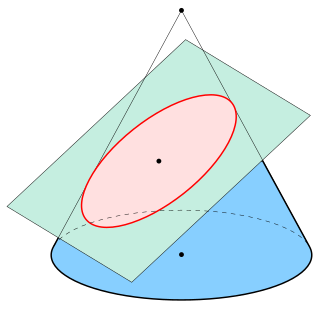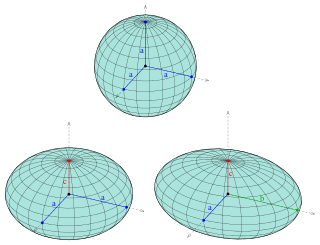
In mathematics, an ellipse is a plane curve surrounding two focal points, such that for all points on the curve, the sum of the two distances to the focal points is a constant. It generalizes a circle, which is the special type of ellipse in which the two focal points are the same. The elongation of an ellipse is measured by its eccentricity , a number ranging from to .
The ellipsis... is a series of dots that indicates an intentional omission of a word, sentence, or whole section from a text without altering its original meaning. The plural is ellipses. The term originates from the Ancient Greek: ἔλλειψις, élleipsis meaning 'leave out'.

In astronomy, Kepler's laws of planetary motion, published by Johannes Kepler between 1609 and 1619, describe the orbits of planets around the Sun. The laws modified the heliocentric theory of Nicolaus Copernicus, replacing its circular orbits and epicycles with elliptical trajectories, and explaining how planetary velocities vary. The three laws state that:
- The orbit of a planet is an ellipse with the Sun at one of the two foci.
- A line segment joining a planet and the Sun sweeps out equal areas during equal intervals of time.
- The square of a planet's orbital period is proportional to the cube of the length of the semi-major axis of its orbit.
In electrodynamics, elliptical polarization is the polarization of electromagnetic radiation such that the tip of the electric field vector describes an ellipse in any fixed plane intersecting, and normal to, the direction of propagation. An elliptically polarized wave may be resolved into two linearly polarized waves in phase quadrature, with their polarization planes at right angles to each other. Since the electric field can rotate clockwise or counterclockwise as it propagates, elliptically polarized waves exhibit chirality.

An ellipsoid is a surface that can be obtained from a sphere by deforming it by means of directional scalings, or more generally, of an affine transformation.
Ellipses is the plural form of two different English words:

Galaxy morphological classification is a system used by astronomers to divide galaxies into groups based on their visual appearance. There are several schemes in use by which galaxies can be classified according to their morphologies, the most famous being the Hubble sequence, devised by Edwin Hubble and later expanded by Gérard de Vaucouleurs and Allan Sandage. However, galaxy classification and morphology are now largely done using computational methods and physical morphology.

A cylinder has traditionally been a three-dimensional solid, one of the most basic of curvilinear geometric shapes. In elementary geometry, it is considered a prism with a circle as its base.

In astrodynamics or celestial mechanics, an elliptic orbit or elliptical orbit is a Kepler orbit with an eccentricity of less than 1; this includes the special case of a circular orbit, with eccentricity equal to 0. In a stricter sense, it is a Kepler orbit with the eccentricity greater than 0 and less than 1. In a wider sense, it is a Kepler orbit with negative energy. This includes the radial elliptic orbit, with eccentricity equal to 1.
In mathematics, an ellipse is a geometrical figure.
Continuity editing is the process, in film and video creation, of combining more-or-less related shots, or different components cut from a single shot, into a sequence to direct the viewer's attention to a pre-existing consistency of story across both time and physical location. Often used in feature films, continuity editing, or "cutting to continuity", can be contrasted with approaches such as montage, with which the editor aims to generate, in the mind of the viewer, new associations among the various shots that can then be of entirely different subjects, or at least of subjects less closely related than would be required for the continuity approach. When discussed in reference to classical Hollywood cinema, it may also be referred to as classical continuity.
An oval is a closed curve in a plane which resembles the outline of an egg. The term is not very specific, but in some areas it is given a more precise definition, which may include either one or two axes of symmetry of an ellipse. In common English, the term is used in a broader sense: any shape which reminds one of an egg. The three-dimensional version of an oval is called an ovoid.
Astronomia nova is a book, published in 1609, that contains the results of the astronomer Johannes Kepler's ten-year-long investigation of the motion of Mars.

An elliptical wing is a wing planform whose leading and trailing edges each approximate two segments of an ellipse. It is not to be confused with annular wings, which may be elliptically shaped.
An elliptic equation can mean:
In linguistics, ellipsis or an elliptical construction is the omission from a clause of one or more words that are nevertheless understood in the context of the remaining elements. There are numerous distinct types of ellipsis acknowledged in theoretical syntax. Theoretical accounts of ellipsis seek to explain its syntactic and semantic factors, the means by which the elided elements are recovered, and the status of the elided elements. Theoretical accounts of ellipsis can vary greatly depending in part upon whether a constituency-based or a dependency-based theory of syntactic structure is pursued.
Ellipsis is the narrative device of omitting a portion of the sequence of events, allowing the reader to fill in the narrative gaps. Aside from its literary use, the ellipsis has a counterpart in film production. It is there to suggest an action by simply showing what happens before and after what is observed. The vast majority of films use ellipses to clear actions that add nothing to the narrative. Beyond these "convenience" ellipses, ellipses are also used to advance the story.
An ellipsis is a punctuation mark comprised a series of dots: ...

A trammel of Archimedes is a mechanism that generates the shape of an ellipse. It consists of two shuttles which are confined ("trammeled") to perpendicular channels or rails and a rod which is attached to the shuttles by pivots at fixed positions along the rod.
This page is based on this
Wikipedia article Text is available under the
CC BY-SA 4.0 license; additional terms may apply.
Images, videos and audio are available under their respective licenses.







